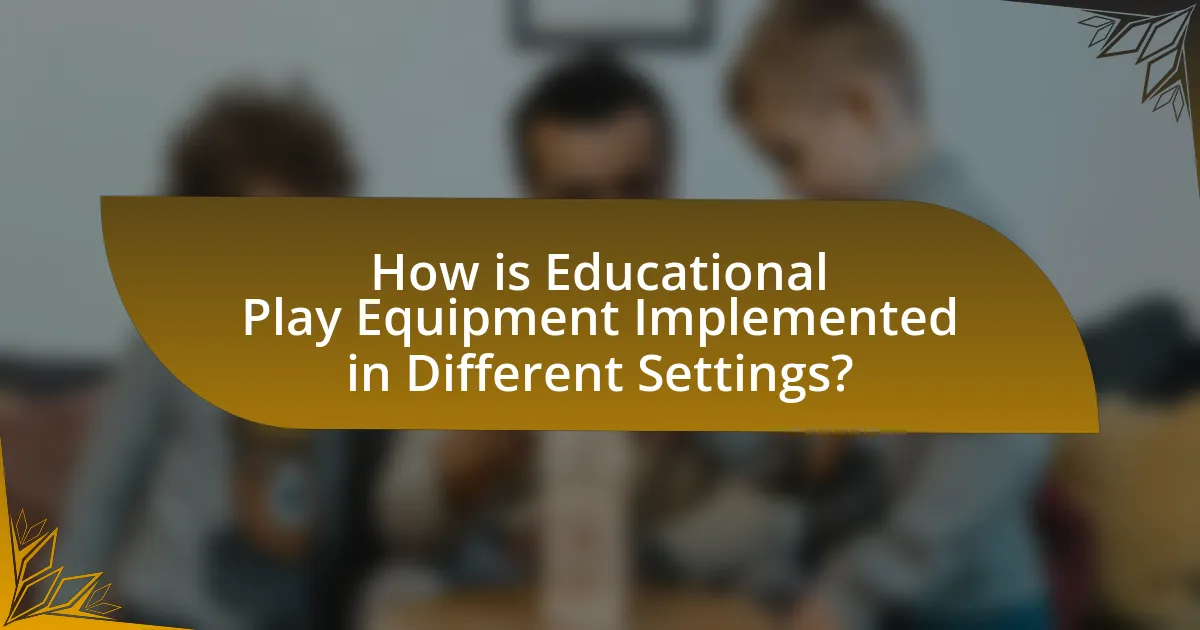The article focuses on incorporating educational elements into play equipment, emphasizing features that promote learning and development through play. It outlines how interactive components, such as puzzles and sensory panels, enhance cognitive skills, creativity, and social interactions among children. The discussion includes various types of educational elements, their benefits for cognitive and social development, and best practices for implementing such equipment in schools and community settings. Additionally, it highlights the importance of community involvement and feedback in designing effective educational play spaces, as well as practical tips for selecting appropriate equipment that aligns with educational goals.

What are Educational Elements in Play Equipment?
Educational elements in play equipment are features designed to promote learning and development through play. These elements often include interactive components that encourage problem-solving, creativity, and social skills. For instance, play equipment may incorporate puzzles, musical instruments, or sensory panels that stimulate cognitive and sensory development. Research indicates that children who engage with educational play equipment demonstrate improved language skills and enhanced social interactions, supporting the idea that play is a critical component of early childhood education.
How do educational elements enhance play experiences?
Educational elements enhance play experiences by promoting cognitive development and critical thinking skills. When play equipment incorporates educational features, such as puzzles, numbers, or language elements, children engage in problem-solving and learning while playing. Research indicates that play-based learning can improve retention of knowledge and foster creativity, as children are more likely to explore and experiment in a playful context. For instance, a study published in the Journal of Educational Psychology found that children who participated in play-based learning activities demonstrated higher levels of engagement and understanding compared to traditional learning methods. This integration of educational elements not only makes play more enriching but also supports holistic development in children.
What types of educational elements can be incorporated?
Various educational elements can be incorporated into play equipment, including cognitive skills development, physical activity, social interaction, and sensory experiences. Cognitive skills can be enhanced through puzzles and problem-solving activities integrated into the equipment, promoting critical thinking and creativity. Physical activity can be encouraged through climbing structures and balance beams, which improve motor skills and coordination. Social interaction is fostered by collaborative play features, such as group games or shared spaces that require teamwork. Sensory experiences can be provided through tactile surfaces, sound elements, and visual stimuli, which engage children’s senses and support sensory development. These elements are supported by research indicating that play-based learning significantly enhances children’s overall development and learning outcomes.
How do these elements support cognitive development?
Incorporating educational elements into play equipment supports cognitive development by providing interactive experiences that enhance problem-solving skills and critical thinking. For instance, play equipment designed with puzzles or challenges encourages children to engage in logical reasoning and decision-making processes. Research indicates that children who participate in play that incorporates educational elements demonstrate improved cognitive skills, such as memory retention and spatial awareness, as they navigate through various tasks and scenarios. This active engagement fosters neural connections in the brain, which are essential for cognitive growth and development.
Why is it important to integrate education into play?
Integrating education into play is important because it enhances cognitive development while engaging children in enjoyable activities. Research indicates that play-based learning fosters critical thinking, problem-solving skills, and creativity, which are essential for academic success. For instance, a study published in the journal “Child Development” by researchers from the University of California found that children who participated in play-based educational programs showed significant improvements in literacy and numeracy skills compared to those in traditional learning environments. This evidence underscores the value of combining educational elements with play to promote holistic development in children.
What benefits do children gain from educational play equipment?
Children gain cognitive, social, and physical development benefits from educational play equipment. This type of equipment encourages problem-solving skills, enhances creativity, and promotes teamwork through interactive play. Research indicates that children who engage with educational play equipment show improved language skills and better emotional regulation. For instance, a study published in the Journal of Educational Psychology found that children who participated in structured play activities demonstrated a 20% increase in critical thinking skills compared to those who did not. Additionally, educational play equipment often incorporates elements that teach basic math and literacy concepts, further supporting academic readiness.
How does educational play equipment influence social skills?
Educational play equipment enhances social skills by providing interactive environments that encourage collaboration, communication, and problem-solving among children. This type of equipment often includes features that require teamwork, such as group games or shared tasks, which promote social interaction. Research indicates that children who engage with educational play equipment develop better social competencies, including empathy and conflict resolution skills, as they navigate social dynamics during play. For instance, a study published in the Journal of Child Development found that children who participated in cooperative play activities showed significant improvements in their ability to communicate effectively and work with peers.

What are the Key Features of Educational Play Equipment?
Key features of educational play equipment include interactive learning components, safety and durability, and age-appropriate design. Interactive learning components, such as puzzles and games, promote cognitive development and problem-solving skills. Safety and durability ensure that the equipment can withstand frequent use while minimizing injury risks, as evidenced by safety standards set by organizations like ASTM International. Age-appropriate design caters to the developmental stages of children, facilitating engagement and learning through play. These features collectively enhance the educational value of play equipment, making it a vital tool in early childhood development.
How can play equipment be designed to be educational?
Play equipment can be designed to be educational by integrating interactive features that promote cognitive, social, and physical development. For instance, incorporating puzzles, numbers, and letters into climbing structures encourages problem-solving and literacy skills. Research indicates that play environments that include educational elements can enhance children’s learning outcomes; a study published in the Journal of Play and Learning found that children engaged with educational play equipment showed a 30% improvement in early math skills compared to those who used traditional play structures. Additionally, using materials that encourage sensory exploration, such as textures and colors, can stimulate curiosity and creativity, further supporting educational growth.
What role does interactivity play in educational equipment?
Interactivity enhances educational equipment by actively engaging learners, which improves retention and understanding of concepts. Research indicates that interactive tools, such as touchscreens and responsive learning environments, facilitate hands-on experiences that cater to various learning styles. For instance, a study published in the Journal of Educational Psychology found that students using interactive simulations scored 20% higher on assessments compared to those using traditional methods. This demonstrates that interactivity not only makes learning more enjoyable but also significantly boosts educational outcomes.
How can sensory experiences be integrated into play equipment?
Sensory experiences can be integrated into play equipment by incorporating various textures, sounds, and visual stimuli that engage multiple senses. For instance, play structures can feature tactile panels with different materials such as sandpaper, rubber, and fabric to encourage touch exploration. Additionally, sound elements like musical instruments or noise-making devices can be embedded within the equipment to stimulate auditory senses. Visual stimuli can include bright colors, moving parts, or light displays that attract attention and encourage interaction. Research indicates that sensory-rich environments enhance cognitive development and social skills in children, supporting the effectiveness of these integrations in play equipment.
What materials are best for educational play equipment?
Wood, plastic, and metal are the best materials for educational play equipment. Wood is durable, safe, and provides a natural aesthetic that encourages imaginative play. Plastic is lightweight, weather-resistant, and can be molded into various shapes, making it ideal for interactive elements. Metal offers strength and longevity, suitable for structures that require stability. Research indicates that these materials not only enhance the safety and longevity of play equipment but also support cognitive and physical development in children through engaging and interactive designs.
How do different materials affect safety and learning outcomes?
Different materials significantly impact safety and learning outcomes in play equipment. For instance, soft materials like rubber and foam reduce the risk of injury during falls, promoting a safer play environment. Research indicates that playgrounds with safety surfacing made from these materials have lower injury rates, enhancing children’s willingness to explore and engage in learning activities. Additionally, materials that are visually stimulating, such as brightly colored plastics or textured surfaces, can enhance cognitive development by encouraging sensory exploration and imaginative play, which are crucial for learning. Studies show that children exposed to diverse materials in play settings demonstrate improved problem-solving skills and creativity, further linking material choice to educational outcomes.
What sustainable materials can be used in educational play equipment?
Sustainable materials that can be used in educational play equipment include bamboo, recycled plastic, and natural rubber. Bamboo is a rapidly renewable resource known for its strength and durability, making it suitable for various play structures. Recycled plastic, often sourced from post-consumer waste, reduces landfill impact and can be molded into various shapes for educational purposes. Natural rubber, derived from rubber trees, is biodegradable and provides a safe, non-toxic surface for play areas. These materials not only contribute to environmental sustainability but also ensure safety and longevity in educational play equipment.

How is Educational Play Equipment Implemented in Different Settings?
Educational play equipment is implemented in various settings such as schools, childcare centers, and community parks to enhance learning through play. In schools, equipment like interactive learning panels and sensory play structures are integrated into the curriculum to support cognitive development and social skills. Childcare centers often utilize age-appropriate toys and games that promote fine motor skills and problem-solving abilities, aligning with early childhood education standards. Community parks may feature inclusive play structures that encourage physical activity and social interaction among children of diverse abilities, fostering a sense of community and cooperation. Research indicates that play-based learning significantly improves children’s engagement and retention of educational concepts, validating the effectiveness of educational play equipment across these settings.
What are the best practices for incorporating educational elements in schools?
The best practices for incorporating educational elements in schools include integrating hands-on learning experiences, utilizing technology effectively, and fostering collaboration among students. Hands-on learning experiences, such as interactive play equipment, engage students and enhance their understanding of concepts through practical application. Research by the National Association for the Education of Young Children emphasizes that play-based learning promotes cognitive and social development, making it essential for educational settings.
Utilizing technology, such as educational apps and interactive whiteboards, can enhance traditional teaching methods and provide diverse learning opportunities. A study published in the Journal of Educational Technology & Society found that technology integration in classrooms significantly improves student engagement and learning outcomes.
Fostering collaboration among students through group activities and projects encourages communication and teamwork skills. According to the Collaborative for Academic, Social, and Emotional Learning, collaborative learning environments lead to improved academic performance and social skills. These practices collectively create a dynamic educational environment that supports holistic student development.
How can educators assess the effectiveness of educational play equipment?
Educators can assess the effectiveness of educational play equipment by observing children’s engagement, learning outcomes, and developmental progress during play. This assessment involves tracking specific metrics such as the frequency of use, the duration of play sessions, and the types of skills being developed, such as problem-solving, social interaction, and motor skills. Research indicates that play equipment designed with educational elements can enhance cognitive and physical development; for instance, a study published in the “Journal of Early Childhood Research” found that children using interactive play structures showed a 30% improvement in fine motor skills compared to those using traditional equipment. By systematically collecting data on these factors, educators can evaluate whether the play equipment meets educational goals and supports children’s overall development.
What role do parents play in supporting educational play at home?
Parents play a crucial role in supporting educational play at home by actively engaging in their children’s play activities and providing resources that enhance learning. They facilitate educational play by selecting toys and materials that promote cognitive skills, such as puzzles and building blocks, which have been shown to improve problem-solving abilities and spatial awareness. Research indicates that children who engage in guided play with their parents demonstrate higher levels of creativity and critical thinking. Furthermore, parents can create an enriching environment by incorporating educational themes into everyday play, such as using storytelling to enhance language skills or integrating math concepts through games. This involvement not only fosters a love for learning but also strengthens the parent-child bond, making playtime both educational and enjoyable.
How can communities promote educational play equipment?
Communities can promote educational play equipment by organizing fundraising events and collaborating with local businesses to secure financial support. These initiatives can lead to the installation of play structures that incorporate learning elements, such as interactive panels that teach math or science concepts. Research indicates that play equipment designed with educational features enhances cognitive development; for instance, a study by the American Academy of Pediatrics highlights that children who engage with educational play equipment show improved problem-solving skills and creativity. By actively engaging parents, educators, and local organizations in the planning and implementation process, communities can ensure that the play equipment meets educational goals while also being enjoyable for children.
What initiatives can be taken to fund educational play projects?
To fund educational play projects, initiatives such as public-private partnerships, grant applications, and community fundraising campaigns can be implemented. Public-private partnerships can leverage resources from both government entities and private organizations, enhancing financial support for educational play initiatives. Grant applications to foundations focused on education and child development can provide substantial funding; for instance, the Robert Wood Johnson Foundation offers grants specifically for projects that promote healthy play. Community fundraising campaigns, including crowdfunding platforms, can engage local stakeholders and raise awareness while generating financial contributions from families and local businesses. These initiatives collectively create a robust funding ecosystem for educational play projects.
How can community feedback shape the design of educational play spaces?
Community feedback can significantly shape the design of educational play spaces by ensuring that the needs and preferences of users are directly incorporated into the planning process. Engaging with parents, educators, and children allows designers to gather insights on what educational elements are most beneficial and appealing, such as interactive learning stations or nature-based play areas. Research indicates that play spaces designed with community input are more likely to be utilized effectively, as they reflect the specific educational goals and cultural values of the community. For instance, a study by the National Association for the Education of Young Children found that play environments tailored to community feedback enhance children’s learning experiences and promote social interaction.
What are some practical tips for selecting educational play equipment?
When selecting educational play equipment, prioritize items that promote cognitive, social, and physical development. Look for equipment that encourages problem-solving, creativity, and collaboration, such as building blocks or interactive games. Ensure the materials are safe, durable, and age-appropriate, as safety standards are crucial for children’s well-being. Additionally, consider equipment that aligns with educational goals, such as STEM-focused toys that enhance learning in science, technology, engineering, and mathematics. Research indicates that play-based learning significantly boosts children’s engagement and retention of knowledge, making the right selection vital for effective educational outcomes.
